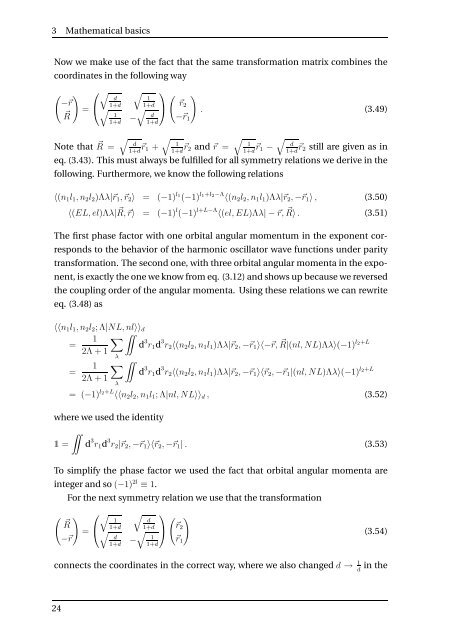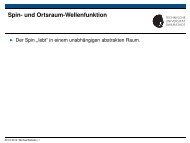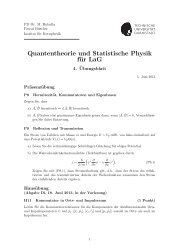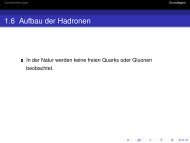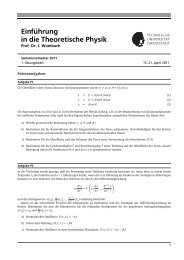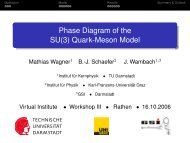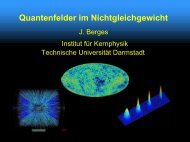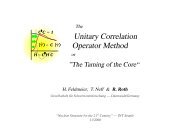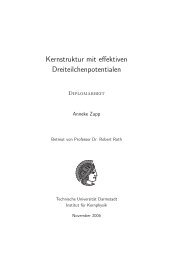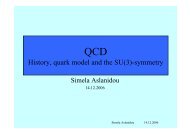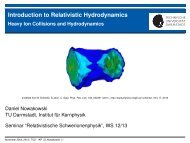Consistent chiral three-nucleon interactions in ... - Theory Center
Consistent chiral three-nucleon interactions in ... - Theory Center
Consistent chiral three-nucleon interactions in ... - Theory Center
You also want an ePaper? Increase the reach of your titles
YUMPU automatically turns print PDFs into web optimized ePapers that Google loves.
3 Mathematical basics<br />
Now we make use of the fact that the same transformation matrix comb<strong>in</strong>es the<br />
coord<strong>in</strong>ates <strong>in</strong> the follow<strong>in</strong>g way<br />
d<br />
⎛<br />
−r<br />
R<br />
1+d<br />
= ⎝<br />
1<br />
1+d −<br />
Note that R =<br />
<br />
1<br />
1+d <br />
d<br />
1+d<br />
⎞ <br />
⎠<br />
r2<br />
−r1<br />
. (3.49)<br />
<br />
d<br />
1+dr1 <br />
1 + 1+dr2 and r =<br />
<br />
1<br />
1+dr1 <br />
d − 1+dr2 still are given as <strong>in</strong><br />
eq. (3.43). This must always be fulfilled for all symmetry relations we derive <strong>in</strong> the<br />
follow<strong>in</strong>g. Furthermore, we know the follow<strong>in</strong>g relations<br />
〈(n1l1, n2l2)Λλ|r1,r2〉 = (−1) l1 (−1) l1+l2−Λ 〈(n2l2, n1l1)Λλ|r2, −r1〉 , (3.50)<br />
〈(EL, el)Λλ| R,r〉 = (−1) l (−1) l+L−Λ 〈(el, EL)Λλ| − r, R〉 . (3.51)<br />
The first phase factor with one orbital angular momentum <strong>in</strong> the exponent cor-<br />
responds to the behavior of the harmonic oscillator wave functions under parity<br />
transformation. The second one, with <strong>three</strong> orbital angular momenta <strong>in</strong> the expo-<br />
nent, is exactly the one we know from eq. (3.12) and shows up because we reversed<br />
the coupl<strong>in</strong>g order of the angular momenta. Us<strong>in</strong>g these relations we can rewrite<br />
eq. (3.48) as<br />
〈〈n1l1, n2l2; Λ|NL, nl〉〉d<br />
1 <br />
¨<br />
=<br />
2Λ + 1<br />
λ<br />
1 <br />
¨<br />
=<br />
2Λ + 1<br />
λ<br />
d 3 r1d 3 r2〈(n2l2, n1l1)Λλ|r2, −r1〉〈−r, R|(nl, NL)Λλ〉(−1) l2+L<br />
d 3 r1d 3 r2〈(n2l2, n1l1)Λλ|r2, −r1〉〈r2, −r1|(nl, NL)Λλ〉(−1) l2+L<br />
= (−1) l2+L 〈〈n2l2, n1l1; Λ|nl, NL〉〉d , (3.52)<br />
where we used the identity<br />
¨<br />
1 =<br />
d 3 r1d 3 r2|r2, −r1〉〈r2, −r1| . (3.53)<br />
To simplify the phase factor we used the fact that orbital angular momenta are<br />
<strong>in</strong>teger and so (−1) 2l ≡ 1.<br />
For the next symmetry relation we use that the transformation<br />
⎛<br />
R<br />
= ⎝<br />
−r<br />
<br />
1<br />
1+d <br />
d<br />
1+d −<br />
<br />
d<br />
1+d<br />
<br />
1<br />
1+d<br />
⎞ <br />
r2 ⎠<br />
r1<br />
(3.54)<br />
connects the coord<strong>in</strong>ates <strong>in</strong> the correct way, where we also changed d → 1 <strong>in</strong> the d<br />
24


